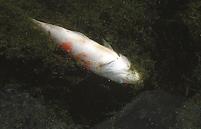|
Koi Deaths in Summer
First
posted in the
Koi Blog
on May 18, 2005
As of this writing, the sweltering heat of Manila 2005 has
already claimed the lives of three of my koi. The temperature
is hovering around
38-39 deg C
(100-102 deg F) these past two weeks. The funny thing is, we
do get short spells of strong rains in between longer periods
of scorching temperatures. Something weird is really happening
to global climates nowadays.
Back to my dead koi – they are actually my three least
favorite koi. This means that it isn’t true after all that
only your favorite koi die. One is a 14-inch Kujaku, which
had over the past year developed a cloud of gray and
ugly-looking stains on its head, losing the clear,
sparkling head that it had when it was just 5 inches long.
The other was an emaciated Gin Rin Kohaku and the third
was a Shiro Utsuri that had a defect (a yellow mark) on
its cheek.
I don’t feel good losing these koi, but I do feel very
relieved that, for a change, I didn’t lose my favorite koi
this time. It would be harder for me to accept the losses
if these involved any of my remaining Kohaku’s, or that
full-bodied locally-bred Sanke that people often mistake
for a Japanese-bred one.

Figure 1. Koi Deaths in Summer can be Avoided
High summer temperatures shouldn’t be a problem for
deep,
well-circulated
ponds. But my pond is not deep, having
been built when I was still an over-excited, uninitiated
newbie in koi keeping. Water problems in our area
prevented me from making it deeper after I knew better,
since the extra depth wouldn’t have mattered anyway if we
didn’t have water to fill it up. But now I realize that
maybe I should’ve gone that extra mile. Well, the dry
season is almost over, so I guess making the pond deeper
is less urgent now, and can wait until next year.
Hot weather can kill koi in a number of ways, the most
common of which is oxygen deprivation due to the reduced
oxygen levels in the pond. Shading a pond and keeping the
water well-circulated go a long way in keeping your koi
cool, and alive. Experts say that at 90 deg F, only 7 ppm
of dissolved oxygen can remain in fresh water, and koi
start dying at 3 ppm of dissolved oxygen. It is
recommended therefore, to have an extra air pump or two to aid
in oxygenating your pond during summer.
Low oxygen levels can also
hamper
your
biological
filtration,
since good bacteria need oxygen. As such, it would be a
good idea to check your water parameters more frequently
during hot summer days, just to ensure that the ammonia,
nitrite, and nitrate levels are not getting out of control
without you knowing it.
And have you noticed those unsightly clumps of
dark green matter that cover the surface of your pond on hot
days? These are actually decaying organic matter in the
pond that get precipitated at the surface of the pond.
These are solid wastes that need to be mechanically filtered
out, and will never be eradicated by your biological filters.
Fortunately,
they are also quite easy to get rid of, extremely irritating
as they are.
Just install a
surface
skimmer
in your pond, which is basically an apparatus designed to suck
the pond's surface water and filter out the wastes.
Lastly,
parasites
reproduce more rapidly during summer.
Watch out for fish lice - a single fish can contaminate the
entire pond in several days. Once that happens, it would
be very difficult to eliminate them permanently without
draining the pond.
Koi are cold-water fish, and having them in hot places
like Manila certainly has detrimental effects on them. Still,
koi keeping is becoming more and more popular in Southeast
Asia. Well, there’s only one thing to blame for this – their
elegant beauty that is so difficult to resist.
See also:
Koi Care
HOME
|

